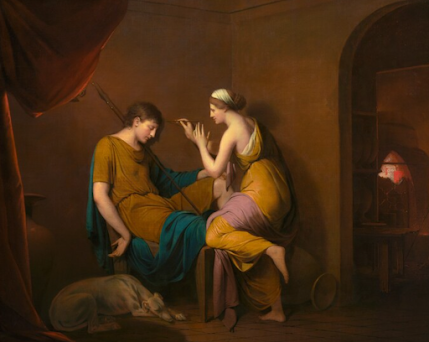Romantic Landscape Era
Upper Fall of the Reichenbach: Rainbow (1810) by J. M. W. Turner
This piece really stood out to me because even though so much of the same color of brown and whites are used to depict the mountainside it is still full of contrast and texture and the depth is shown so brilliantly with how small the human in the lower left corner looks and the magnitude of the rainbow show with it arching over the mountainside. The emotions I feel when seeing this are wonder and awe, it reinforces how vast and beautiful nature is. As one of my sources states when talking about landscape painting during this time period "These artists emphasized transient and dramatic effects of light, atmosphere, and colour to portray a dynamic natural world capable of evoking awe and grandeur."(Britannica).
John Constable - British -1776 - 1837 - Wivenhoe Park, Essex 1816
Oil On Canvas - Widener Collection
I chose this piece because of the rich color contrasts and depth of the scene showing the closeness of the cows in their pasture, the red mansion back behind the trees, the reflection of the sky within the water, and the cloud configuration in the sky. This painting feels like it is alive and like a modern-day photograph with all the details. All these different colors in this painting make you use your imagination and feel the emotions of the elements, the light and airy feel of the clouds in the light blue sky, the dark green and mellow feeling of the lake, the grazing relaxation of the cows among the brown fencing and green pasture. As one of my source's states "Constable believed that it was through depictions of light and sky that the painter expressed emotions, capturing what he termed the “chiaroscuro of nature,” evanescent effects of light and dark experienced outdoors. Later in the century, the impressionist painters were to take up this goal as well." (Wivenhoe)
Heroism and Protesting
Liberty Leading the People (July 28, 1830) Artist: Eugène Delacroix
I was drawn to this piece because of how much is happening in the piece and how the heroine in the middle captures your attention. the rich colors of the clothing and the depth in the scene created by the smoke and buildings in the background is great artistry. This era of romanticism was artists depicting scenes of heroes or heroines during times of sorrow and/or war. This artist is described as ". The greatest French Romantic painter was Eugène Delacroix, who is notable for his free and expressive brushwork, his rich and sensuous use of colour, his dynamic compositions, and his exotic and adventurous subject matter, ranging from North African Arab life to revolutionary politics at home."(Artincontext)
The Raft of the Medusa Artist: Théodore Géricault
This piece was amazing to me because the color aesthetic is a green and brown hue and at the same time it has so much texture, depth and contrast. The shadows between the bodies on the boat and the depth of the incoming waves and orange cast of the sky back behind is beautiful. This painting is also a depiction of a very dark and harrowing event that is described as " the Medusa, which ran aground off the coast of Senegal. Because of a shortage of lifeboats, some 150 survivors embarked on a raft and were decimated by starvation during a 13-day ordeal, which descended into murder and cannibalism. Only a handful remained when they were rescued at sea."(Britannica). To read of such a horrific ordeal and to have an artist create such a beautiful and interesting peace of art is and awe to me.
Compare and Contrast
Overall, both these styles are very beautiful and captured my eye, but if I had to choose, I would want the esthetics and depictions of nature of the landscape era in my home and around my family and friends for appreciation.
The landscape era was something that artists started in romantic era times because it was true appreciation for their surroundings and nature, of the earth and environment that provided for them. The artist Turner was said to have "introduced the landscape as an equally significant component of genre art, with paintings of everyday scenes of life– at the time, this was a revolutionary choice. Turner was celebrated as “the painter of light” because of his mastery of depicting luminous colors and atmosphere." (Artincontext)
The Heroism and Protesting era during this period reminds me of a rebellious teenager standing up to authority and even if their voices are not heard they have amazing depictions of these historical figures and events. During the Napolean era and fall and rise of other leaders, artist showed their support for freedom and inspiring movements through art, like one of my sources says the The Raft of the Medusa is "Intended as a profound critique of a social and political system by depicting the tragic consequences and suffering of the marginal members of society, the painting is a pioneering example of protest art."(The Art Story).
Works Cited
“Romanticism Movement Overview.” The Art Story, https://www.theartstory.org/movement/romanticism/.
“Romanticism.” Encyclopædia Britannica, Encyclopædia Britannica, Inc., https://www.britannica.com/art/Romanticism.
“Wivenhoe Park, Essex.” John Constable, Wivenhoe Park, Essex, 1816, https://www.nga.gov/collection/highlights/constable-wivenhoe-park-essex.html.
Artincontext. “Famous Romanticism Paintings - the Best Examples of Romantic-Era Art.” Artincontext.org, 2 June 2022, https://artincontext.org/famous-Romanticism-paintings/.
Britannica, The Editors of Encyclopaedia. "The Raft of the Medusa". Encyclopedia Britannica, 30 Jan. 2022, https://www.britannica.com/topic/The-Raft-of-the-Medusa. Accessed 1 November 2022.






Comments
Post a Comment